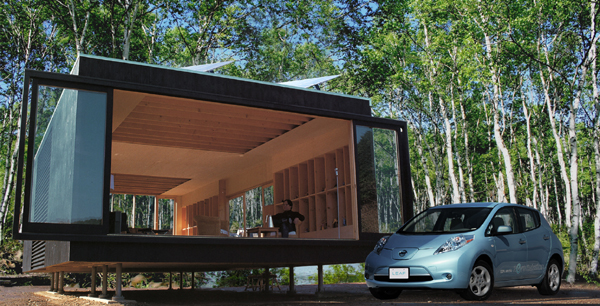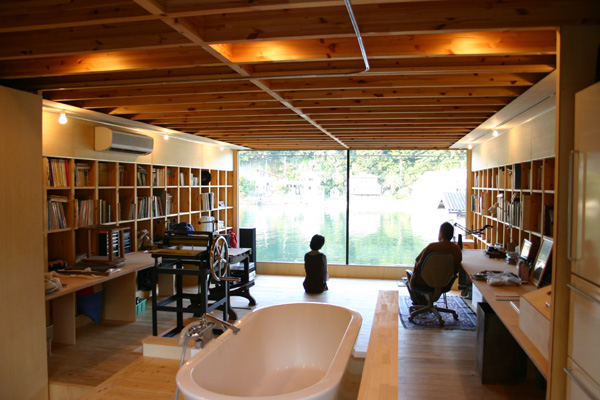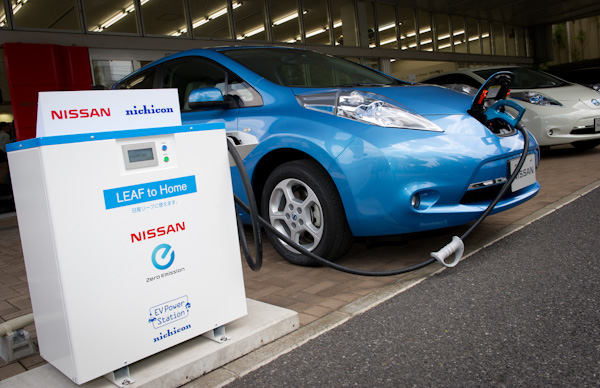The 2011 Tōhoku earthquake tsunami disaster has had a profound effect on Japan. On the physical level, the shutdown of the country’s nuclear reactors has caused the Japanese government to set ambitious energy usage reduction targets in certain regions (you might have caught our recent article about Konarka planting “Green Curtains” at its offices in an effort to save electricity — the company has even gone so far as to set its thermostats higher and relax its dress code in the summer to give its AC units a break).
On the psychological level, according to the Japanese advertising agency known as TBWA\HAKUHODO, the earthquake and tsunami disaster altered the country’s fundamental view of the world, “bringing home to us the realization that infrastructure is fragile and energy is never guaranteed.” Which led the agency to address two questions: Can we live without modern infrastructure? And if so, what will the future of Japan look like?

If all this seems a bit of an ambitious line of thought, it’s worth noting here that TBWA\HAKUHODO is not your average ad agency. From the outset, it’s a company that sought to distinguish itself through innovation, and that innovation has taken the form of something called its Human Centered Open Innovation (HCOI) Lab, which was established to develop platforms to unite technologies and companies in creating unique solutions to consumer needs. Put another way, rather than simply marketing the products that its clients come to them with, this team analyzes human needs and desires to help companies develop products.
Together with its long-term client Nissan — as well as nineteen other companies — TBWA\HAKUHODO’s HCOI team took on the challenging of imagining what the off-grid future of Japan might look like. The result is an inspiring example of truly human-centered innovation: a house known as MIRAI NIHON, or Future Japan.

Mirai Nihon makes use of technologies that have been developed by TBWA\HAKUHODO’s clients but have not yet been commercialized. The base of the home is an Solar Design Laboratory’s Aerohouse, a basic, modernist box composed of engineered wood and plywood that can fit easily on the back of a semi truck, making the home mobile enough to set up wherever it’s needed. Off-grid power here is provided via Altima Corporation’s Organic Photovoltanic Film, coupled with an Uninterruptible Power Supply (UPS) system from Japan Capacitor Industrial Systems and a Home Power Storage System from NEC Corporation. A Home Energy Management System from Nissin Systems Corporation helps to ensure that the home operates at peak efficiency.
And if all that stored sunlight harvested by the home’s solar array should become exhausted, fear not: your Nissan Leaf, working in conjunction with its Leaf to Home Residential Power Supply (developed by Nichon for Nissan), will have enough stored juice to power your home for up to two days.

Not only does the home come equipped with a water purification capable of bringing polluted and unsanitary water up to potable standards, via the New Meridian Tech Company’s Crystal Valley Water Purification System, it comes with the company’s accompanying seawater unit. Apparently, these units work together to pass water first through activated charcoal, then through a reverse osmosis filter with openings so small (approx.0.0001 microns) that micro organisms and bacteria cannot pass through it (and neither can the large molecules of a saline solution).
Which means, effectively, that anyone who lives in the house that embodies the future of Japan can drink directly out of the ocean (and brush their teeth and bathe with seawater too).
Mitsuru Takamatsu, Chief Strategic Officer of TBWA\HAKUHODO — and the HCOi team leader — told us, “Japanese firms have applied their sophisticated technological capabilities to create numerous innovative products. However, we believe true innovation, innovation that enriches our lives, must be based on consumer needs, not technology-driven development.”
He goes on to note that his agency’s HCOI Lab gathers the technologies needed to bring product ideas to life, based on “the consumer’s voice.” “The Laboratory seeks to avoid thinking based on product output—the typical corporate perspective. Instead, it gathers the technologies needed and seeks to realize and introduce products consumers truly want.”
In this case, consumer increasingly concerned with their dependance on that “fragile” infrastructure, who want the security and peace of mind that comes from an off-grid house that can be set up anywhere and supply the basics of modern life.
Interested in living in a MIRAI NIHON? These home systems (minus the Leaf) are now commercially available through TBWA\HAKUHODO and its partners. With all of its off-grid bells and whistles included, the home runs $211,570 for the 66-square-meter (710-square-foot) version, and $180,257 for the 49-square-meter (527-square-foot) version — not including shipping costs from Japan. (And if that seems just a bit too small, you can easily size up the home, if you’re not concerned about picking it up and taking it with you when the next disaster hits.)